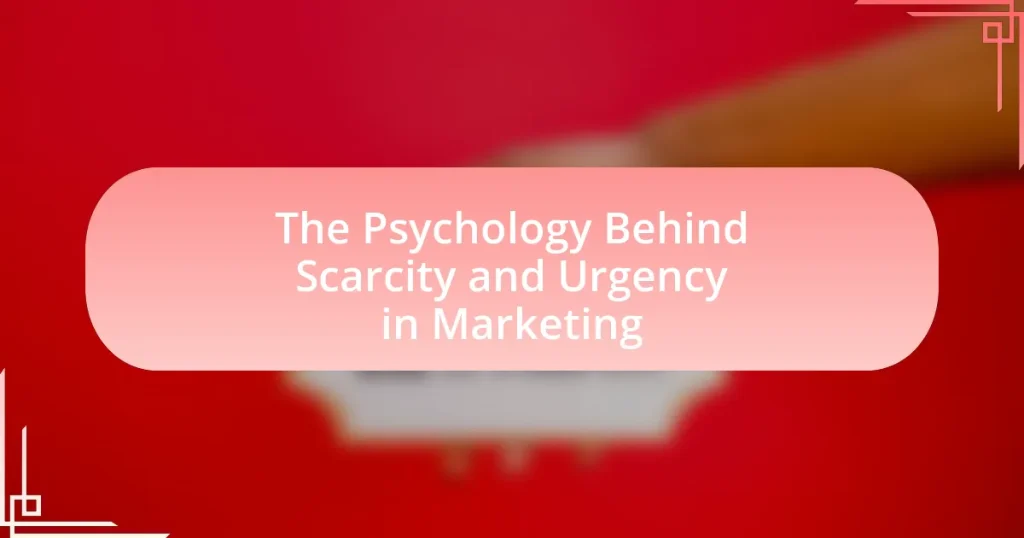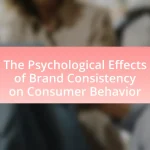The article explores the psychology behind scarcity and urgency in marketing, highlighting how these concepts influence consumer behavior and decision-making. It discusses key psychological principles such as loss aversion, the scarcity heuristic, and social proof, which enhance the perceived value of products when they are presented as limited in availability or time-sensitive. The effectiveness of these strategies is supported by research, indicating that they can significantly increase sales and consumer engagement. Additionally, the article addresses potential pitfalls of using scarcity and urgency, including customer distrust and buyer’s remorse, while offering best practices for ethical marketing.
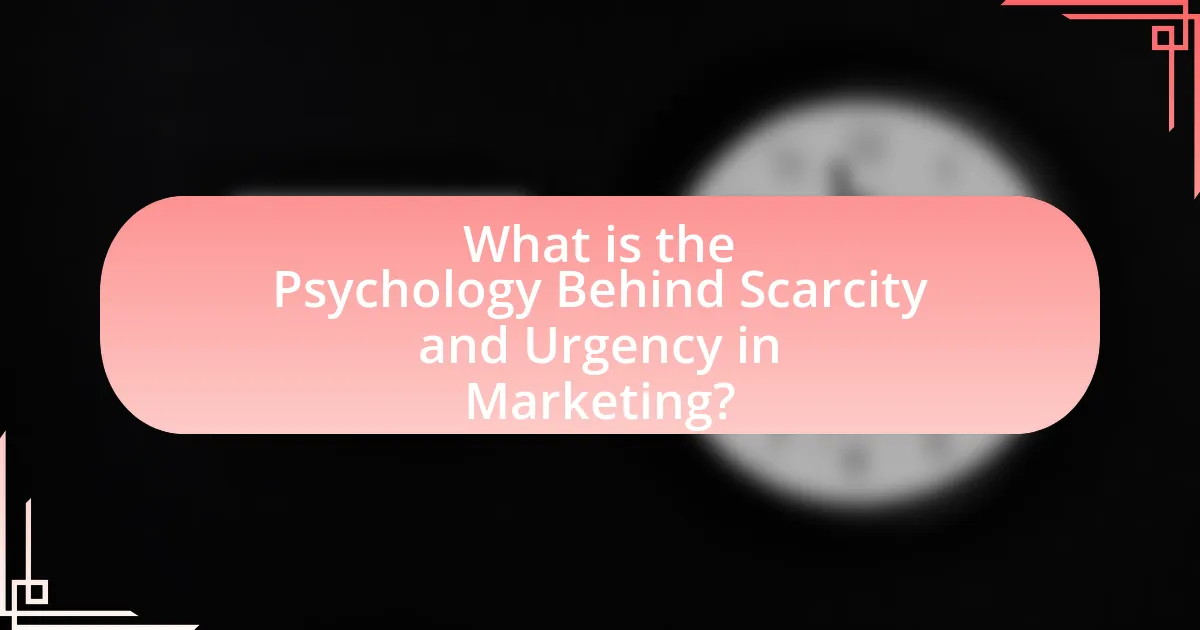
What is the Psychology Behind Scarcity and Urgency in Marketing?
The psychology behind scarcity and urgency in marketing is rooted in the principles of human behavior that prioritize limited availability and time constraints, leading to increased perceived value and motivation to act. Scarcity creates a fear of missing out (FOMO), which triggers emotional responses that compel consumers to make quicker purchasing decisions. Research by Cialdini (2009) highlights that when items are perceived as scarce, individuals are more likely to desire them, as scarcity signals higher value. Additionally, urgency, often communicated through time-limited offers, enhances this effect by creating a sense of immediacy, further driving consumers to act swiftly to secure the opportunity. This combination of scarcity and urgency effectively influences consumer behavior, leading to increased sales and engagement.
How do scarcity and urgency influence consumer behavior?
Scarcity and urgency significantly influence consumer behavior by creating a perception of limited availability and time constraints, which can drive immediate purchasing decisions. When consumers perceive that a product is scarce, such as limited stock or exclusive offers, they often feel a heightened sense of value and desirability, leading to increased motivation to buy. Research by Cialdini (2009) indicates that scarcity can enhance the perceived value of an item, as consumers associate limited availability with higher quality. Similarly, urgency, often communicated through time-sensitive promotions, compels consumers to act quickly to avoid missing out, as evidenced by studies showing that countdown timers can increase conversion rates by up to 9%. Together, these psychological triggers create a powerful impetus for consumers to make quicker purchasing decisions, often resulting in impulse buys.
What psychological principles underlie the effects of scarcity?
The psychological principles underlying the effects of scarcity include the concepts of loss aversion, the scarcity heuristic, and social proof. Loss aversion, a principle from behavioral economics, suggests that individuals prefer to avoid losses rather than acquire equivalent gains; thus, when something is scarce, the fear of missing out amplifies its perceived value. The scarcity heuristic indicates that people often equate limited availability with higher quality, leading them to prioritize scarce items over abundant ones. Social proof, another psychological principle, suggests that individuals look to others’ behaviors to guide their own decisions; when they see others valuing scarce items, they are more likely to desire those items themselves. These principles are supported by research, such as the study by Cialdini et al. (1975), which demonstrated that limited-time offers significantly increase consumer interest and urgency.
How does urgency impact decision-making processes?
Urgency significantly influences decision-making processes by creating a heightened sense of importance and prompting quicker responses. When individuals perceive a limited time to act, they often prioritize immediate choices over long-term considerations, leading to impulsive decisions. Research indicates that urgency can trigger emotional responses, such as fear of missing out, which further accelerates decision-making. For instance, a study published in the Journal of Consumer Research found that consumers are more likely to make purchases when they believe an offer is time-sensitive, demonstrating that urgency can effectively drive consumer behavior and increase sales.
Why are scarcity and urgency effective marketing strategies?
Scarcity and urgency are effective marketing strategies because they create a psychological trigger that compels consumers to act quickly. When items are perceived as limited in availability or time-sensitive, it heightens the fear of missing out (FOMO), leading to increased consumer motivation to purchase. Research by Cialdini (2009) in “Influence: Science and Practice” demonstrates that people are more likely to desire what they believe is scarce, as it suggests higher value and exclusivity. Additionally, a study published in the Journal of Consumer Research found that limited-time offers can significantly boost sales by creating a sense of urgency, prompting quicker decision-making among consumers.
What evidence supports the effectiveness of these strategies?
Research demonstrates that scarcity and urgency significantly enhance consumer behavior and decision-making. A study by Cialdini et al. (1975) found that limited availability increases perceived value, leading to higher purchase intentions. Additionally, a meta-analysis by Gierl and Huettl (2010) confirmed that urgency tactics, such as time-limited offers, effectively boost sales by creating a fear of missing out. These findings indicate that implementing scarcity and urgency strategies in marketing can lead to increased consumer engagement and sales performance.
How do these strategies create a sense of value for consumers?
Scarcity and urgency strategies create a sense of value for consumers by leveraging the psychological principle that limited availability increases desirability. When consumers perceive that a product is scarce or available for a limited time, they often feel a heightened sense of urgency to purchase, fearing they might miss out. This phenomenon is supported by research from Cialdini, which indicates that scarcity can enhance perceived value by suggesting exclusivity and higher demand. For example, limited-time offers or exclusive releases can lead consumers to believe that the product is more valuable because it is not widely accessible, thus driving quicker purchasing decisions.
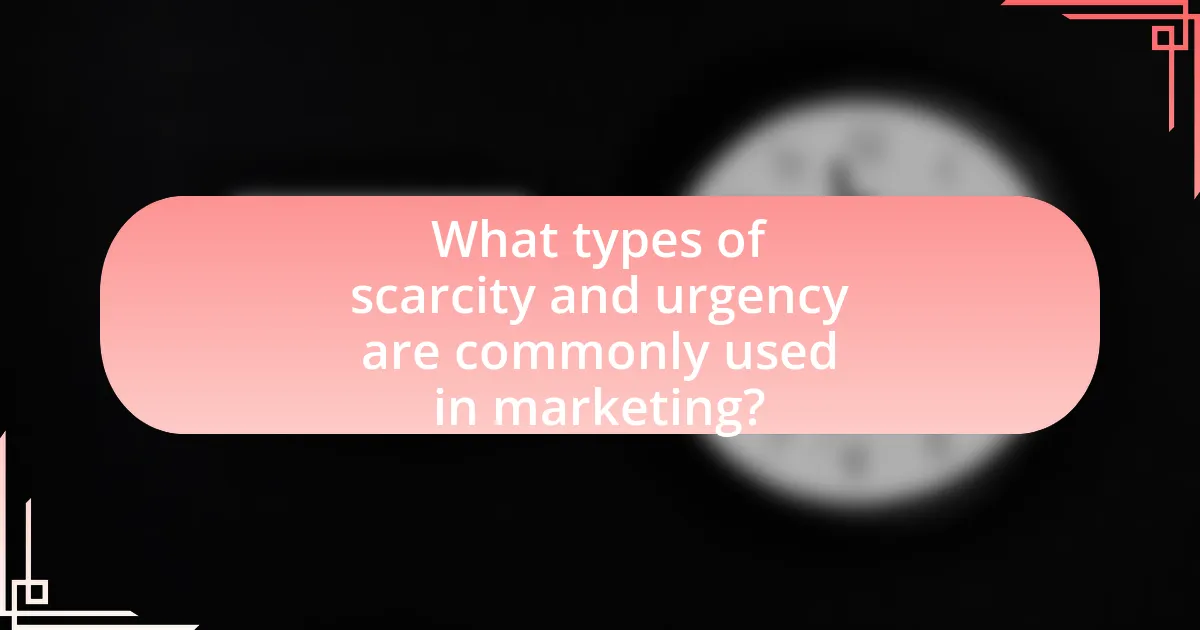
What types of scarcity and urgency are commonly used in marketing?
Common types of scarcity and urgency used in marketing include limited-time offers, limited quantity promotions, and exclusive access. Limited-time offers create urgency by encouraging consumers to act quickly before the deal expires, often seen in flash sales or countdown timers. Limited quantity promotions instill scarcity by highlighting that only a certain number of items are available, which can lead to increased demand and quicker purchasing decisions. Exclusive access, such as members-only sales or pre-release products, leverages both scarcity and urgency by making consumers feel special and prompting immediate action to secure their opportunity. These strategies are effective because they tap into the psychological principles of loss aversion and the fear of missing out, driving consumer behavior towards quicker purchasing decisions.
How do marketers implement scarcity tactics?
Marketers implement scarcity tactics by creating a perception of limited availability of products or services. This can be achieved through strategies such as limited-time offers, exclusive releases, or stating that only a certain number of items are left in stock. For instance, a study published in the Journal of Consumer Research found that consumers are more likely to purchase items that are presented as scarce, as this triggers a fear of missing out (FOMO). By leveraging these tactics, marketers effectively increase demand and urgency, leading to higher conversion rates.
What are the different forms of scarcity in marketing?
The different forms of scarcity in marketing include time-based scarcity, quantity-based scarcity, and social scarcity. Time-based scarcity creates urgency by limiting the duration of an offer, such as flash sales or limited-time promotions, which can increase consumer motivation to purchase. Quantity-based scarcity involves limiting the number of available items, such as exclusive product releases or limited edition items, which can enhance perceived value and desirability. Social scarcity refers to the perception that a product is in high demand or popular, often highlighted through phrases like “only a few left” or “bestseller,” which can trigger a fear of missing out among consumers. These forms of scarcity leverage psychological triggers that can significantly influence consumer behavior and decision-making in marketing contexts.
How can limited-time offers create urgency?
Limited-time offers create urgency by instilling a fear of missing out (FOMO) in consumers, prompting them to make quicker purchasing decisions. This psychological trigger is effective because it leverages the scarcity principle, which suggests that people perceive items as more valuable when they are less available. Research indicates that urgency can increase conversion rates; for example, a study published in the Journal of Consumer Research found that limited-time promotions can lead to a 30% increase in sales compared to standard offers. By creating a deadline, marketers compel consumers to act swiftly, thereby enhancing the likelihood of immediate purchases.
What role does social proof play in scarcity and urgency?
Social proof significantly enhances the effectiveness of scarcity and urgency in marketing by validating consumer decisions through the behavior of others. When potential buyers observe that a product is in limited supply or that others are purchasing it rapidly, they are more likely to feel compelled to act quickly to avoid missing out. Research indicates that 70% of consumers are influenced by the actions of others, demonstrating that social proof can amplify the perceived value of scarce items. This psychological mechanism drives urgency, as individuals are motivated to conform to the behavior of their peers, leading to increased sales and faster decision-making.
How does social proof enhance the perception of scarcity?
Social proof enhances the perception of scarcity by demonstrating that others are actively engaging with a limited resource, which increases its perceived value. When individuals observe others purchasing or expressing interest in a scarce item, they interpret this behavior as a signal of the item’s desirability and urgency. Research indicates that social validation can amplify the urgency to act, as seen in studies where consumers are more likely to buy products labeled as “limited stock” when they see others doing so. This phenomenon is rooted in the psychological principle that people often look to others for cues on how to behave, especially in uncertain situations, thereby reinforcing the urgency created by scarcity.
What examples illustrate the impact of social proof on urgency?
Examples illustrating the impact of social proof on urgency include limited-time offers that showcase how many people are currently viewing or purchasing a product. For instance, e-commerce platforms often display messages like “Only 3 left in stock!” or “10 people are viewing this item right now!” These notifications create a sense of urgency by leveraging social proof, as potential buyers perceive that others are interested, prompting them to act quickly to avoid missing out. Research by Cialdini in “Influence: The Psychology of Persuasion” supports this, indicating that individuals are more likely to make decisions when they see others doing the same, especially in situations perceived as scarce.
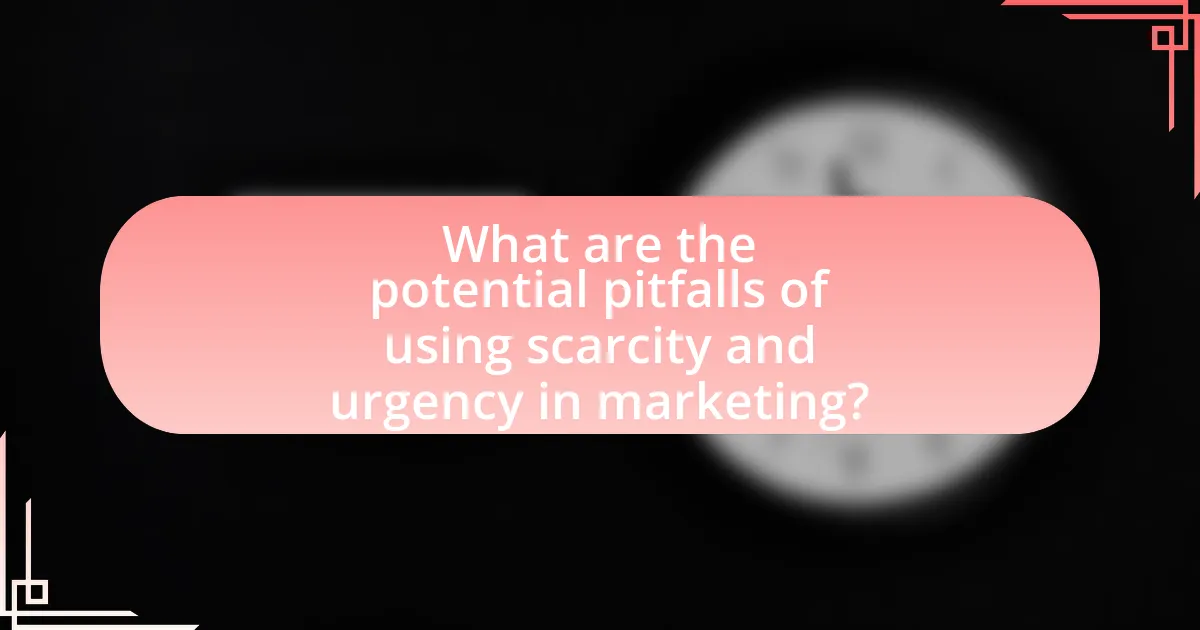
What are the potential pitfalls of using scarcity and urgency in marketing?
The potential pitfalls of using scarcity and urgency in marketing include customer distrust, diminished brand loyalty, and potential backlash. When consumers perceive scarcity tactics as manipulative, they may develop skepticism towards the brand, leading to a loss of trust. Research indicates that 61% of consumers feel manipulated by urgency tactics, which can result in negative brand associations. Additionally, overuse of these strategies can lead to customer fatigue, where consumers become desensitized to urgency claims, ultimately reducing their effectiveness. Furthermore, if customers feel pressured into making hasty decisions, they may experience buyer’s remorse, which can harm long-term relationships with the brand.
How can overuse of these tactics backfire?
Overuse of scarcity and urgency tactics can backfire by leading to consumer distrust and desensitization. When customers frequently encounter exaggerated claims of limited availability or time-sensitive offers, they may begin to perceive these tactics as manipulative, resulting in skepticism towards the brand. Research indicates that 61% of consumers feel manipulated by scarcity tactics when overused, which can diminish brand loyalty and negatively impact long-term sales. Additionally, excessive reliance on these strategies can create a backlash effect, where consumers actively avoid brands that they believe employ deceptive marketing practices.
What are the risks of creating false scarcity?
Creating false scarcity can lead to significant risks, including damage to brand reputation and customer trust. When consumers discover that a product is not genuinely scarce, they may feel manipulated, resulting in negative perceptions of the brand. Research indicates that 70% of consumers are less likely to purchase from a brand they perceive as dishonest. Additionally, false scarcity can lead to backlash on social media, where dissatisfied customers may share their experiences, amplifying the negative impact. This can ultimately result in decreased sales and long-term customer loyalty issues, as trust is a critical factor in consumer decision-making.
How can urgency lead to buyer’s remorse?
Urgency can lead to buyer’s remorse by prompting consumers to make hasty purchasing decisions without fully evaluating their needs or the product’s value. When marketers create a sense of urgency, such as limited-time offers or low stock alerts, consumers may feel pressured to act quickly, often resulting in impulsive purchases. Research indicates that this pressure can diminish the likelihood of thorough consideration, leading to regret once the consumer reflects on their decision. A study published in the Journal of Consumer Research found that consumers who felt rushed were more likely to experience dissatisfaction with their purchases, highlighting the psychological impact of urgency on decision-making.
What ethical considerations should marketers keep in mind?
Marketers should prioritize honesty and transparency in their communications. Ethical considerations include avoiding deceptive practices, such as false scarcity claims or misleading information about product availability. Research indicates that consumers are more likely to trust brands that provide clear and accurate information, which can enhance brand loyalty and long-term success. Additionally, marketers should consider the psychological impact of urgency tactics on consumer behavior, ensuring that these strategies do not exploit vulnerabilities or lead to regretful purchases. Ethical marketing practices not only comply with legal standards but also foster a positive brand reputation and consumer trust.
How can marketers balance urgency with transparency?
Marketers can balance urgency with transparency by clearly communicating the reasons behind time-sensitive offers while ensuring that customers understand the value of the product or service. For instance, using phrases like “limited-time offer due to high demand” provides urgency while also explaining the context, which fosters trust. Research indicates that transparency in marketing can enhance customer loyalty; a study by the Journal of Marketing found that consumers are more likely to respond positively to brands that are honest about their practices and limitations. This approach not only drives immediate action but also builds long-term relationships with customers.
What guidelines can help ensure ethical use of scarcity tactics?
To ensure ethical use of scarcity tactics, marketers should prioritize transparency, honesty, and consumer welfare. Transparency involves clearly communicating the nature of the scarcity, such as whether it is genuine or artificially created. Honesty requires that marketers do not exaggerate the limited availability of products or services, as misleading claims can erode trust. Additionally, prioritizing consumer welfare means considering the potential negative impact of urgency on decision-making, ensuring that consumers have adequate time to make informed choices. Research indicates that ethical marketing practices enhance brand loyalty and customer satisfaction, reinforcing the importance of these guidelines.
What best practices can marketers follow when using scarcity and urgency?
Marketers should create genuine scarcity and urgency by clearly communicating limited availability and time-sensitive offers. This can be achieved by using phrases like “only a few left” or “offer ends soon,” which trigger a fear of missing out (FOMO) among consumers. Research indicates that scarcity can increase perceived value; for instance, a study published in the Journal of Consumer Research found that consumers are more likely to desire products that are less available. Additionally, marketers should ensure that the scarcity is authentic to maintain trust; false claims can lead to customer dissatisfaction and damage brand reputation. By combining clear messaging with genuine limitations, marketers can effectively leverage scarcity and urgency to drive sales.
How can marketers effectively communicate scarcity without misleading consumers?
Marketers can effectively communicate scarcity without misleading consumers by providing transparent information about product availability and using clear, factual language. For instance, stating “Only 10 items left in stock” accurately reflects the situation and encourages urgency without deception. Research indicates that consumers respond positively to genuine scarcity cues, as demonstrated in a study published in the Journal of Consumer Research, which found that perceived scarcity can enhance product desirability when consumers believe the information is truthful. By ensuring that scarcity claims are based on actual inventory levels and avoiding exaggerated statements, marketers maintain trust and foster a positive relationship with consumers.
What strategies can enhance the effectiveness of urgency in campaigns?
To enhance the effectiveness of urgency in campaigns, marketers can implement time-limited offers, which create a sense of scarcity and compel immediate action. Research indicates that consumers are more likely to make a purchase when they perceive a limited time to act, as demonstrated by a study published in the Journal of Consumer Research, which found that urgency significantly increases conversion rates. Additionally, using countdown timers in promotions can visually reinforce the urgency, leading to a 9% increase in sales according to data from marketing analytics firms. Another effective strategy is to highlight limited stock availability, as this taps into the fear of missing out (FOMO), further motivating consumers to act quickly.
